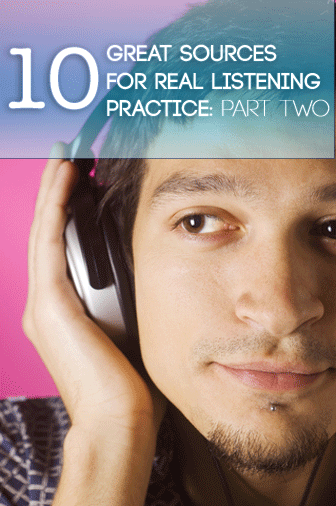10 Great Sources for Real Listening Practice: Part Two


Unfortunately, listening materials designed for use with ESL classes lack several elements present in non-ESL targeted material. There is a way, though, to get beyond the ESL bubble and into the world of authentic listening activities.
What ESL Materials Lack
ESL materials, like any teaching materials, are modified from authentic language sources to encourage learning and accomplishment for the student. However, listening activities created for ESL classrooms lack several elements present in authentic spoken English. This may not be an issue with early learners, but more advanced students should be challenged to work with authentic materials and further their listening skills. If you limit your class materials to those designed for ESL use, your students will lack exposure to the following qualities of authentic speech.
ESL listening materials lack realistic intonation which tends to be less exaggerated. Exaggerated intonation may aid in comprehension but more likely is seen as silly or is perceived as irritating by adult students. Additionally, the rate of speech in formulated materials tends to be steady rather than varied in speed like that of native speech. The pronunciation will also be unrealistic. Speakers will enunciate more and lack assimilation and elision that are present in natural speech. There will also be differences in syntax. Speakers will use simple sentence structures and clearly composed, complete sentences. In authentic speech, speakers more often speak in incomplete sentences and lengthy, sometimes ungrammatical sentences. Conversations recorded for ESL materials also have clear turn taking between speakers. More realistically, native speakers of English will interrupt and speak over one another. Native speakers also tend to speak more or less in a conversation; in prefabricated materials, there is usually a relatively equal division of speaking time. There are also vocabulary differences between fabricated and authentic listening texts. ESL texts tend to lack use of slang and limit the amount of vocabulary used. Finally, in authentic listening situations there is often background noise and other aural stimuli distracting from the listening text which is not found in classroom materials.
Public Announcements
One way to bring authentic listening activities into your classroom is to record a listening text in a public place. This type of listening text will have audible distractions and interference while still presenting identifiable information to your students. Try recording an announcement on a bus, subway or plane. Then prepare your students before listening by telling them the context and ask them what they expect to hear. Play the recording for your students multiple times, and then ask them to answer questions about what they heard.
Weather Forecasts
Allow students to listen to a radio weather forecast. This will challenge them to understand content without visual clues. Apply this information by planning activities for the day or choosing what clothing to wear.
Songs
Present students with an incomplete set of lyrics to a popular song. Play the song for the students challenging them to fill in the blanks of the missing lyrics. You can play the song multiple times. This challenges students to guess at missing information in what they hear. Of course, once their lyrics are complete play the song again and give them the opportunity to sing along.
Radio Commercials
Radio Commercials can be used for a variety of activities. They are especially useful if they are by local and nonprofessional radio personalities. These texts will give students exposure to realistic pronunciation, intonation and speed. You can play a selection of commercials for them and ask them to write down particular information, or you can ask them to match various commercials with pictures of the people who recorded them.
Conversations
Take your students into situations where many groups of people are talking at the same time, a party or cafeteria for example. Ask your students to “eavesdrop” on four conversations just enough to note the topic of conversation. Ask students to comment on if they would like to join in each of the conversations. What would they say? This will expose students to varieties in style and also challenge them to guess at missing information in the conversations.
Authentic listening does not happen in isolation, so try to include as many authentic listening activities as you can so long as they relate to what your students are learning. Your students will always be challenged to actively listen when using English. Why not prepare them while they are still students as to what real challenges await them in the listening world of English?